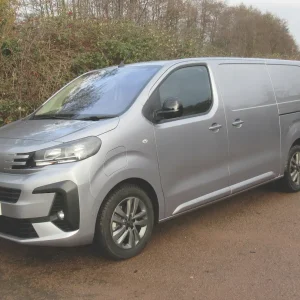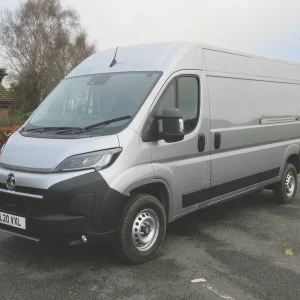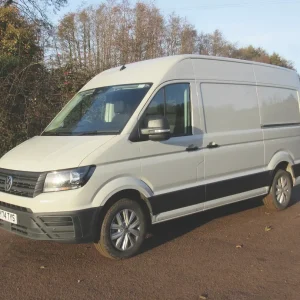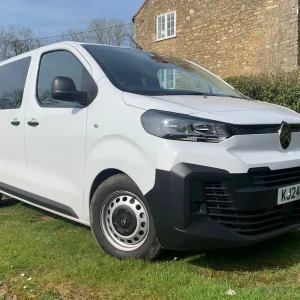Vauxhall’s latest Vivaro is a well thought-out package with impressive diesel engines, good road manners and a decent standard of equipment, with its bold front grille and prominent Vauxhall badge helping the newcomer stand out in the high street.
Unfortunately for Vauxhall, it has been launched in the wake of the frankly stunning Ford Transit Custom, which has raised the game in this sector by a country mile. It’s the new benchmark. So, can the Vivaro match it?
To find out, we sampled a short-wheelbase standard-roof Vivaro 2900 – the figure is an approximation of the gross weight in kilos – in top- of-the-range Sportive trim and powered by a 120hp 1.6-litre twin-turbocharger bi-turbo CDTI diesel. You can order the 1.6-litre bi-turbo at 140hp too, and in single-turbo guise at either 90hp or 115hp.
Also sold as a 2700, the front- wheel drive Vivaro is up for grabs with two different body lengths and two roof heights, although the high-roof variant doesn’t arrive until next year. Load cubes range from 5.2–8.6m3, which means the latest offering delivers more carrying space than its predecessor, while payload capacities extend from getting on for 1100kg to approaching 1250kg.
If the Sportive offers more luxury than you can stand then you will be relieved to know the Vivaro can be ordered in base trim instead. It is also being marketed as a double-cab, with rear seats plus a load area at the back, as a nine-seater Combi, and as a platform cab.
Although the Transit Custom is by far and away the new Vivaro’s key rival, it is not the only one. Mercedes-benz’s Vito, which is in the process of being replaced by a new model, and Volkswagen’s Transporter, which will be replaced next year, both represent stiff competition.
The Vivaro’s sister vehicle, the Renault Trafic, is also a van worthy of consideration.
Cab
Oddment storage facilities in the three-seater cab include a capacious lidded glove box, which unfortunately cannot be locked. Also present are a compartment on top of the fascia on the passenger side of the cab with a poorly fitting lid that’s a characteristic of every Vivaro we’ve seen so far, and an open shelf next to it just behind the radio that looks as though it ought to have a lid. There is a small, lidded compartment to the right of the steering column, and bins are provided in each of the doors.
Sportive trim offers surprisingly versatile passenger accommodation. Flip down the back of the inboard passenger seat and it turns into a desk complete with a cup-holder and a compartment for a laptop. You’ll find more cup-holders at each extremity of the dashboard. Pull up the passenger seat cushions and there is plenty of hidden storage space underneath – just the place to conceal valuable power tools.
It’s good to see nice, chunky controls for the heating and ventilation system that are easy to understand and use. It’s good, too, that both the leather-covered steering wheel and the driver’s seat are height-adjustable.
Load area
If you regularly carry cargo that needs lashing down then this Vivaro is the van for you. Our demonstrator’s 5.2m3 load bay boasted no less than 16 tie-down points, including two either side of the rear door, two either side of the nearside sliding door, and three on each side of the full- height steel bulkhead.
The twin back doors can be latched open at 90° and swung through 165° if you release the user-friendly door stays. The big handles fitted to all the doors make them easy to open and shut even when wearing thick working gloves.
Our test vehicle’s interior was protected to half its height against minor dents and scrapes by plastic panels that cost an extra £80 (all prices quoted here exclude VAT), but there was no protection for either the load bed or the wheel boxes, a deficit the operator would have to remedy.
Maximum load length is 2537mm, but longer loads may still fit thanks to the Sportive’s FlexCargo load-through facility, accessed by lifting a hatch at the bottom of the passenger seat. It offers a potential total length of 3750mm. Maximum cargo bay width is 1662mm narrowing to 1268mm between the wheel boxes while maximum height is 1387mm. The rear loading height is 552mm. The rear door aperture is 1320mm high and 1391mm wide. The dimensions for the side aperture are 1284mm high and 1030mm wide respectively.
Maximum gross payload capacity is 1240kg, and our Vivaro could tow a braked trailer grossing at 2000kg.
Powertrain
The four-cylinder 16-valve twin- turbo diesel generates maximum power at 3500rpm. Top torque of 320Nm bites at 1500rpm and the engine is married to a six-speed manual gearbox.
The sequential turbocharging and twin cooler arrangement the engine relies on is designed to make it more responsive and more frugal at the same time.
Chassis and steering
The Vivaro’s suspension employs independent MacPherson struts at the front while independent four-link progressive-rate mini- block springs help deliver support at the back. Gas-pressure dampers are fitted all round, and our model’s 17-inch alloy wheels came with 215/60 r17C Dunlop econodrive tyres. Those five- spoke alloys will set you back an extra £465. Hydraulic power- assisted rack-and-pinion steering offers an 11.8m kerb-to-kerb turning circle.
Performance
The first thing that strikes you about the vehicle as you accelerate away from rest is how extraordinarily quiet it is. You have to strain your ears to catch any decibels from the engine, while wind noise and road roar are almost completely suppressed.
While marvelling at the sound of silence, you may want to spare a thought for the quality of the gear change. You flick the lever from one set of cogs to the next without any effort at all, and as a consequence are able to get the best out of the engine’s available performance. As well as enabling you to surge away from rest with the minimum of fuss, it also packs ample top- end punch. The Vivaro’s handling might not be quite as pin-sharp as the Transit Custom’s, but it’s sharp enough. The ride could perhaps stand to be better damped, but ride quality cannot be viewed as a significant issue.
All vehicles get, as standard, a blind-spot mirror mounted in the passenger’s sun visor, which should help you to spot cyclists creeping up on the nearside in city centre traffic. However, if there’s carrying a passenger, they may not be keen on staring into it mile after mile and might flip up the visor after a while unless the sunshine is really strong.
Something we were not overly keen on staring at was the Vivaro’s digital speedometer, which smacks of design for design’s sake. Some may wonder why not stick with an analogue speedo?
Equipment
All vans come with electric windows and mirrors – the latter are heated and feature a separate wide-angle section on the driver’s side – a multi- function trip computer and a 12V power point in the dashboard. There is one in the load area too.
Cruise control with a speed limiter and a highly effective air- conditioning system are among the benefits of upgrading to Sportive specifications, as is
a more sophisticated in-cab entertainment package. As well as a digital radio, bluetooth connectivity, a USb socket and remote audio controls on the steering column, you get MP3- compatibilty and a CD player.
Buying and running
A stop-start system that kills the engine if it is allowed to idle wastefully at the lights
or in a traffic jam should help keep fuel consumption and CO2 emissions down.
Push the ‘eco’ button on the gearbox console when either un-laden or lightly laden and
you will make little discernible difference to your on-the-road performance but also enjoy up to 10% better fuel economy.
Service intervals are set at two years/25,000 miles and the Vivaro is protected by a three- year/100,000-mile warranty with no mileage limit in the first year. roadside assistance is provided in year one and the body panel anti-perforation corrosion guarantee lasts for six years.
At the time of writing, the van was being marketed with a package made up of a four-year warranty, four years breakdown assistance, four years free servicing, four years 0% finance, and a £600 contribution by Vauxhall towards the deposit.
Quoted fuel consumption is 47.9mpg on the official combined cycle. We averaged closer to 40mpg.
Safety
The Vivaro comes with electronic stability programme, emergency brake assist, electronic brakeforce distribution, hill-start assist, and a traction control system that helps drivers cope more effectively with loose surfaces. Disc brakes are fitted all round and the Sportive also gets front fog lights and reversing sensors.
Remote central locking is included on all vehicles and allows you to unlock and lock the rear doors separately, plus you can lock all the doors from the driver’s seat if you hit a button on the dashboard.
Verdict
A hugely impressive UK-built package with plenty to offer
History
When the previous Vivaro arrived in 2001 some of Vauxhall’s rivals were somewhat dismissive of its distinctive styling, which included a noticeable bulge above the cab. It would soon date they claimed, and Vauxhall and Renault – like the current model, the old-style Vivaro was a re- badged Trafic with a few styling tweaks – would end up looking foolish.
They had to eat their words because the departing Vivaro looks almost as fresh as it did 13 years ago.
Not that the previous Vivaro remained unchanged throughout its working life; in 2006, it received new powertrains and revised front-end styling.
The Trafic and Vivaro were not the only variations on the same theme. Renault’s sister company Nissan introduced its
own version under the Primastar name, although the Japanese manufacturer seems reluctant to repeat the trick with the new model.
A hugely impressive UK-built package with plenty to offer, yet it risks being permanently in the Transit Custom’s shadow, and that’s a shame.
A hugely impressive UK-built package with plenty to offer, yet it risks being permanently in the Transit Custom’s shadow, and that’s a shame.
A hugely impressive UK-built package with plenty to offer, yet it risks being permanently in the Transit Custom’s shadow, and that’s a shame.





